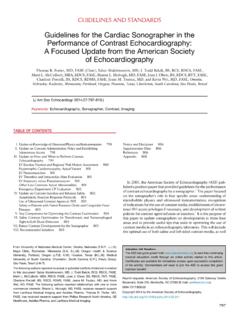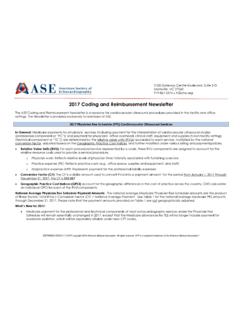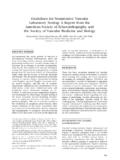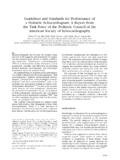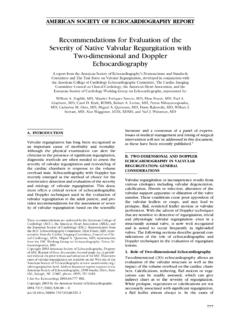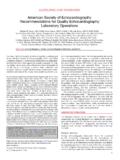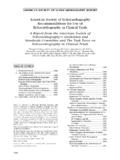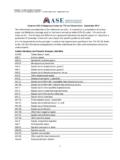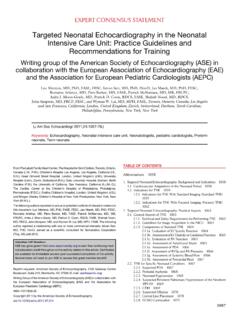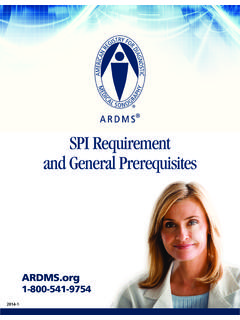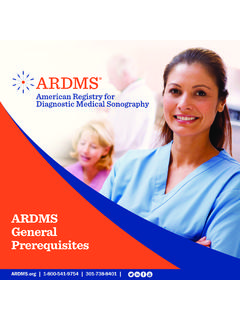Transcription of ASE CONSENSUS STATEMENT Use of Carotid Ultrasound to ...
1 ASE CONSENSUS STATEMENTUse of Carotid Ultrasound to identify SubclinicalVascular Disease and Evaluate CardiovascularDisease Risk: A CONSENSUS STATEMENT from theAmerican Society of EchocardiographyCarotid Intima-Media Thickness Task ForceEndorsed by the Society for vascular MedicineJames H. Stein, MD, FASE, Claudia E. Korcarz, DVM, RDCS, FASE, R. Todd Hurst, MD,Eva Lonn MD, MSc, FASE, Christopher B. Kendall, BS, RDCS, Emile R. Mohler, MD,Samer S. Najjar, MD, Christopher M. Rembold, MD, and Wendy S. Post, MD, MS,Madison, Wisconsin; Scottsdale, Arizona; Hamilton, Ontario, Canada; Philadelphia, Pennsylvania; Baltimore,Maryland; and Charlottesville, VirginiaContinuing Medical Education Course for Use of Carotid Ultrasound to identify subclinical vascular Disease and Evaluate Cardiovas-cular Disease Risk: A CONSENSUS STATEMENT for the American Society of Echocardiography Carotid Intima-Media Thickness Task Force Accreditation STATEMENT :The American Society of Echocardiography is accredited by the Accreditation Council for Continuing Medical Education to provide con-tinuing medical education for American Society of Echocardiography designates this educational activity for a maximum of 1 AMA PRA Category 1 Credits.
2 Physicians should only claim credit commensurate with the extent of their participation in the and CCI recognize ASE s certificates and have agreed to honor the credit hours toward their registry requirements for American Society of Echocardiography is committed to resolving all conflict of interest issues, and its mandate is to retain onlythose speakers with financial interests that can be reconciled with the goals and educational integrity of the educational program. Dis-closure of faculty and commercial support sponsor relationships, if any, have been Audience:1. Physicians, physicians assistants, and nurses with an interest in cardiac and vascular imaging, preventive cardiology, and cardiovas-cular disease risk assessment.
3 2. Ultrasonographers with interest in vascular imaging and cardiovascular disease risk :Upon completing this activity, participants will be able to: 1. Describe the rationale for using Carotid Ultrasound to identify subclinicalvascular disease and to evaluate cardiovascular disease risk. 2. Explain the application of Carotid Ultrasound to cardiovascular diseaserisk assessment. 3. Describe the scanning technique for identifying subclinical vascular disease using Carotid Ultrasound . 4. Explain thekey components of interpreting Carotid Ultrasound studies for cardiovascular disease risk Disclosures:James H. Stein, MD, FASE:Research grants: Siemens Medical Solutions, SonositeIntellectual property: listed as the inventor of Patent #US 6,730,0235 Ultrasonic Apparatus and Method for Providing Quantitative Indi-cation of Risk of Coronary Heart Disease.
4 It has been assigned to the Wisconsin Alumni Research R. Mohler III, MD:Speakers bureau for Merck, BMS-Sanofi and AstraZeneca; Research grant support from BMS-Sanofi, Pfizer and M. Rembold, MD:Advisory Board for Time to Complete This Activity: 1 hourKeywords:Atherosclerosis, Cardiovascular disease, Carotid arteries, Carotid intima-media thickness, Riskfactors, Ultrasound diagnosis, UltrasoundFrom the University of Wisconsin School of Medicine and Public Health, Madison, Wisconsin ( , ); Mayo Clinic, Scottsdale, Arizona ( , ); McMasterUniversity, Faculty of Health Sciences, Hamilton, Ontario, Canada ( ); University of Pennsylvania Medical School, Philadelphia, Pennsylvania ( ); National Instituteon Aging, National Institutes of Health, Baltimore, Maryland ( ); University of Virginia School of Medicine, Charlottesville, Virginia ( ).
5 And Johns HopkinsUniversity, School of Medicine and the Bloomberg School of Public Health, Baltimore, Maryland ( ).Dr Mohler is a representative from the Society for vascular : Dr Stein has received research grants from Siemens Medical Solutions ( $10K/y) and Sonosite ( $10K/y). Dr Stein is inventor of Patent #US 6,730,0235: Ultrasonic Apparatus and Method for Providing Quantitative Indication of Risk of Coronary Heart Disease. This patent deals with Carotid wall thickness, vascular age,and cardiovascular risk. It has been assigned to the Wisconsin Alumni Research Foundation ( $10K/y). Dr Lonn has received research grants from Sanofi-Aventis( $10K/y) and Glaxo-Smith-Kline ( $10K/y).
6 Dr Rembold served on an Advisory Board for Sonosite ( $10K/y). Drs Korcarz, Hurst, Kendall, Mohler, Najjar, and Post haveno conflicts of interest to requests: James H. Stein, MD, FASE, University of Wisconsin School of Medicine and Public Health, 600 Highland Ave, G7/341 CSC (MC 3248), Madison, WI53792 (E-mail: 2008 by the American Society of is great interest in identifying asymptomatic patients at high riskwho might be candidates for more intensive, evidence-based medicalinterventions that reduce cardiovascular disease (CVD) risk. Mea-surement of Carotid intima-media thickness (CIMT) with B-modeultrasound is a noninvasive, sensitive, and reproducible technique foridentifying and quantifying subclinical vascular disease and for eval-uating CVD risk.)
7 To address issues of standardization and helpimprove the availability of experienced clinical laboratories that canperform high-quality CIMT studies, this CONSENSUS document pro-vides recommendations for the use of Carotid Ultrasound for identi-fying and quantifying subclinical vascular disease and for evaluatingCVD risk in clinical practice. Nine published prospective studies thatincluded at least 1000 asymptomatic participants have examinedCIMT and CVD risk. Each study demonstrated that CIMT wassignificantly associated with risk for myocardial infarction, stroke,death from coronary heart disease, or a combination of these most of these studies, the ability of CIMT to predict future CVDevents was independent of traditional risk factors.
8 Furthermore, 9large studies have demonstrated similar or greater predictive powerfor Carotid plaque and CIMT and identifying Carotid plaque can be useful forrefining CVD risk assessment in patients at intermediate CVD risk (ie,patients with a 6%-20% 10-year risk of myocardial infarction orcoronary heart disease death who do not have established coronaryheart disease or coronary disease risk equivalent conditions). Patientswith the following clinical circumstances also might be considered fortesting: (1) family history of premature CVD in a first-degree relative;(2) individuals younger than 60 years old with severe abnormalities ina single risk factor who otherwise would not be candidates forpharmacotherapy; or (3) women younger than 60 years old with atleast two CVD risk factors.
9 This test can be considered if the level ofaggressiveness of therapy is uncertain and additional informationabout the burden of subclinical vascular disease or future CVD risk isneeded. Imaging should not be performed unless the results would beexpected to alter therapy. CIMT testing can reclassify patients atintermediate risk, discriminate between patients with and withoutprevalent CVD, and predict major adverse CVD events. Outcomedata regarding the ability of a management strategy that includesCIMT or plaque screening tests to improve cardiovascular outcomesare limited to changes in patient or physician behavior that would beexpected to reduce CVD recommendations are high-lighted inboldand are also presented in tables.
10 Because a randomized,controlled trial studying the effectiveness of Carotid Ultrasound imagingas a tool to modify preventive therapies and improve CVD outcomeshas not yet been performed, the clinical practice recommendations inthis document are based on the best available observational data. ForCVD risk assessment, Carotid Ultrasound imaging and measurementshould follow the protocol from a large epidemiologic study that re-ported CIMT values in percentiles by age, sex, and race/ethnicity (eg, theAtherosclerosis Risk in Communities Study). The recommended carotidultrasound scanning protocol is described in detail. CIMT measurementsshould be limited to the far wall of the common Carotid artery andshould be supplemented by a thorough scan of the extracranial carotidarteries for the presence of Carotid plaque, to increase sensitivity foridentifying subclinical vascular disease.
